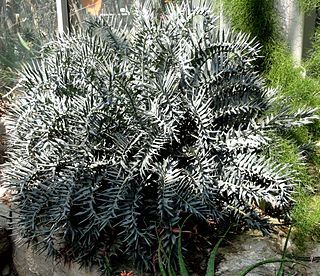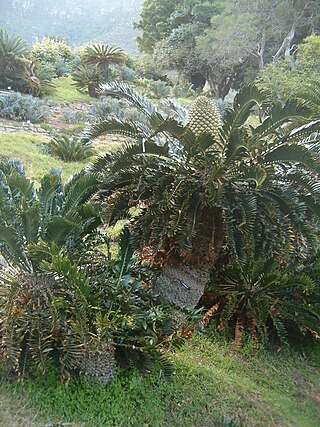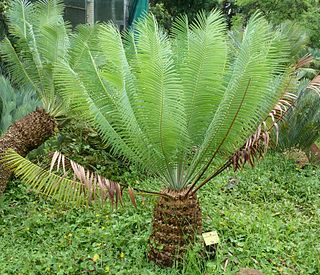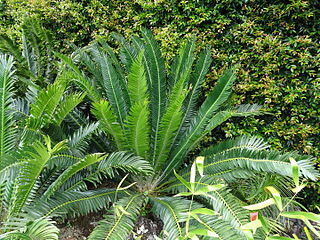
Stangeria eriopus is a cycad endemic to southern Africa. It is the sole species in the genus Stangeria, most closely related to the Australian genus Bowenia, with which it forms the family Stangeriaceae.

Encephalartos woodii, Wood's cycad, is a rare cycad in the genus Encephalartos, and is endemic to the oNgoye Forest of KwaZulu-Natal, South Africa. It is one of the rarest plants in the world, being extinct in the wild with all specimens being clones of the type. The specific and common name both honour John Medley Wood, curator of the Durban Botanic Garden and director of the Natal Government Herbarium of South Africa, who discovered the plant in 1895.

Macrozamia miquelii, is a species of cycad in the plant family Zamiaceae. It is endemic to Queensland and New South Wales in Eastern Australia. Located within sclerophyll forests dominated by eucalyptus trees, the cycad grows on nutrient-poor soils. It is recognised within the Zamiaceae family for its, medium height at 1 m, intermediate size of male and female cones and lighter green leaves compared to other cycads within the plant family of Zamiaceae. The seeds have an orange red sarcotesta which attracts fauna consumption, allowing a mutualistic seed dispersal for the cycad. These seeds are also edible for human consumption if prepared correctly to remove the toxins.

Encephalartos horridus, the Eastern Cape blue cycad, is a small, low-growing cycad up to 0.9 m (3.0 ft) high and 0.9 m (3.0 ft) wide. It is a native of Eastern Cape Province, South Africa, and found in arid shrublands, most commonly on ridges and slopes with shallow soils. The species is particularly known for its distinctly blue-gray leaves, although the degree of coloration can vary significantly. The species name horridus is Latin for 'bristly', after the plant's stiff, spiny leaflets.

Encephalartos villosus is a South African cycad occurring from the East London vicinity, where it is found near the coast, to the northern border of Eswatini (Swaziland) where it may grow as far as 100 km inland. The species is common throughout its range and is the most frequently cultivated in Southern Africa, largely because of its affordable price. As a result of its large geographical distribution, it is notably variable in leaf and cone shape.

Encephalartos ferox, a member of the family Zamiaceae, is a small cycad with 35 cm wide subterranean trunk. It gets its name from the Latin word ferocious, likely from the spine-tipped lobes on the leaves of the plant. It is found naturally on the south-eastern coast of Africa where it has been used by local people for its starch content. It is considered to be one of the most popular cultivated cycads.

Encephalartos altensteinii is a palm-like cycad in the family Zamiaceae. It is endemic to South Africa. The species name altensteinii commemorates Altenstein, a 19th-century German chancellor and patron of science. It is commonly known as the breadtree, broodboom, Eastern Cape giant cycad or uJobane (Zulu). It is listed as vulnerable due to habitat destruction, use for traditional medicine and removal by collectors.

Encephalartos lehmannii is a low-growing palm-like cycad in the family Zamiaceae. It is commonly known as the Karoo cycad and is endemic to South Africa. The species name lehmannii commemorates Prof J.G.C. Lehmann, a German botanist who studied the cycads and published a book on them in 1834. This cycad is listed as near threatened in the IUCN Red List of Threatened Species.

Encephalartos longifolius is a low-growing palm-like cycad in the family Zamiaceae. It is endemic to South Africa and is commonly known as Thunberg's cycad, breadpalm or broodboom. This cycad is listed as near threatened in the IUCN Red List of Threatened Species.

Encephalartos ghellinckii Lem. or Drakensberg cycad is endemic to South Africa, and is one of about 70 species found in sub-Saharan Africa. Strongly associated with the Natal Drakensberg, this 3m tall evergreen species is found from the foothills to fairly high altitudes, growing on stream banks, steep grassy slopes and sandstone outcrops. Its preferred habitat lying within grassveld, it has developed resistance to veldfires, and also the intense cold brought on by snow and frost.

Encephalartos lebomboensis is a species of cycad in the family Zamiaceae. Native to the Lebombo Mountains of South Africa, the species was first described in 1949 by the South African botanist Inez Verdoorn. It is commonly known as the Lebombo cycad, although the name is also used for Encephalartos senticosus which also occurs in the same locality.

Encephalartos senticosus is a species of cycad in the family Zamiaceae native to the Lebombo Mountains of Mozambique, Eswatini (Swaziland), and the KwaZulu-Natal province of South Africa. Prior to its description in 1996, Encephalartos senticosus had been confused with the closely related and sympatric Encephalartos lebomboensis. Both species are commonly known as the Lebombo cycad.

Encephalartos whitelockii is a species of cycad that is native to Uganda.

Encephalartos princeps is a species of cycad that is native to Eastern Cape Province of South Africa.

Encephalartos latifrons is a species of cycad that is native to Eastern Cape province in South Africa at elevations of 200 and 600 metres.

Encephalartos natalensis, the Natal cycad or giant cycad, is a species of cycad that is endemic to the Qumbu and Tabankulu areas of the northern part of the Eastern Cape, and through most of KwaZulu-Natal. The number of mature individuals of this species is declining and the International Union for Conservation of Nature has assessed its conservation status as being "near threatened".

Encephalartos arenarius is a species of cycad in the family Zamiaceae. It is endemic to South Africa, where it is limited to the Eastern Cape. Its common names include Alexandria cycad and dune cycad.

Encephalartos middelburgensis is a species of cycad that is native to Gauteng and Mpumalanga provinces of South Africa at elevations of 1,100–1,400 m (3,600–4,600 ft).

Encephalartos inopinus is a species of cycad that is native to Limpopo Province, South Africa.

The Chimanimani cycad is a species of cycad that is endemic to the Chimanimani Mountains of eastern Zimbabwe. It is a threatened species which has been locally extirpated by cycad collectors.





















